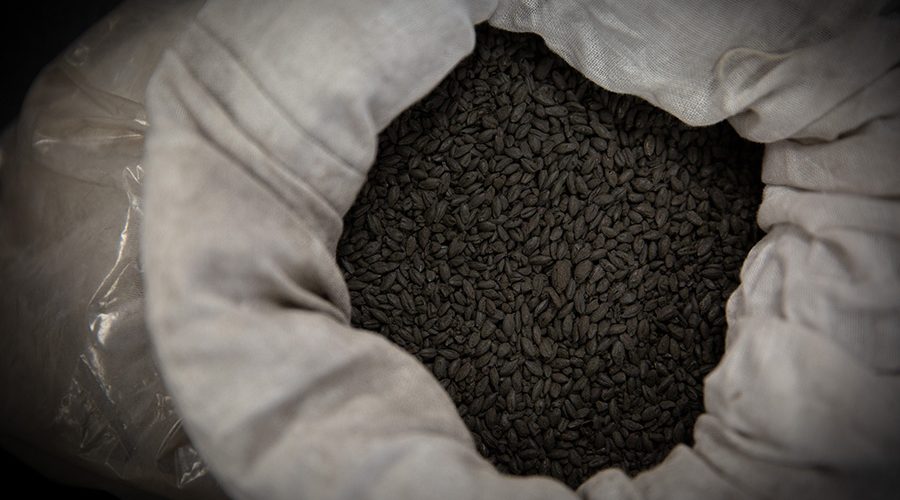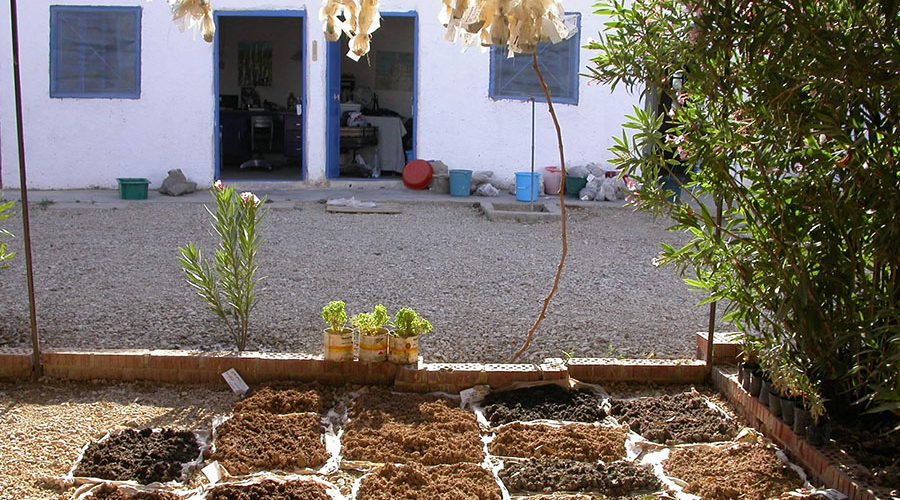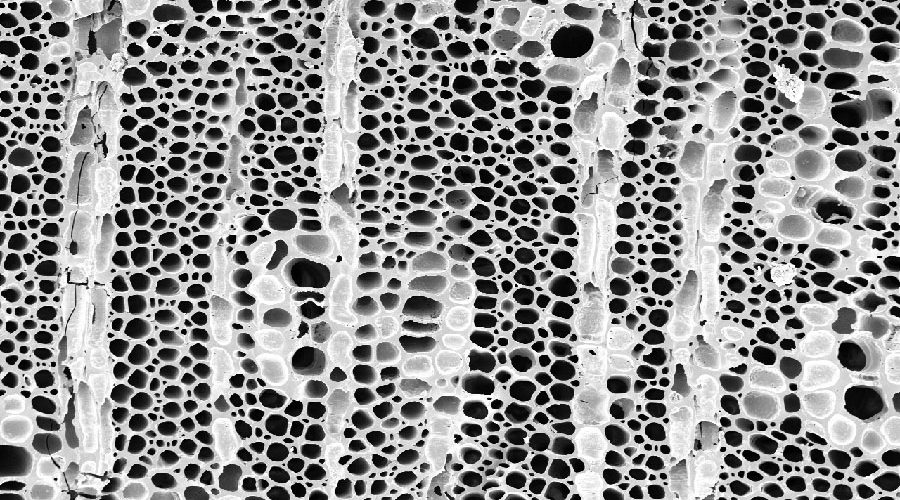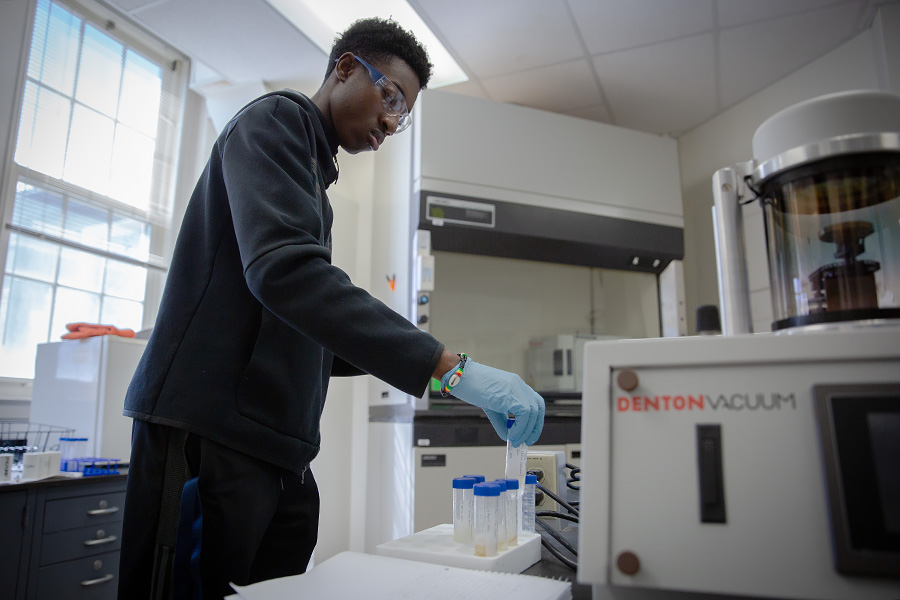About the Lab
The Archaeobotany Laboratory at UConn provides a welcoming and well-equipped space for students and scholars in the Department of Anthropology. Our lab members obtain training and conduct research in archaeobotany method and theory; basic geoarchaeological techniques, including dung spherulite analyses; and fuel use in antiquity.
Research in the lab focuses mostly on ancient agriculture, food and fuel use, and human interactions with the environment. Our work is concentrated within Southwest Asia and spans the Palaeolithic, Epipalaeolithic, Ubaid, Chalcolithic, Bronze Age, and Iron Age periods – and beyond.
Classes taught in the lab include:
- ANTH 2600. Microscopy in Applied Archaeobotany Research (honors core course).
- ANTH 3706/5706. Archaeobotany.
- ANTH 5707. Quantitative Archaeobotany.
- ANTH 5708. Plants and People through the Ages.
The lab also hosts independent studies and honors research (ANTH 4097W. Honors Thesis).
 A threshing sled.
A threshing sled. Ancient grain.
Ancient grain. UConn students examine ancient seeds using microscopes.
UConn students examine ancient seeds using microscopes. Lab director Alexia Smith uses a microscope in the makeshift lab at the Tell Leilan dig house in Syria
Lab director Alexia Smith uses a microscope in the makeshift lab at the Tell Leilan dig house in Syria Flotation samples hanging, and heavy fraction samples drying on the ground in front of the Tell Leilan Archaeobotany lab at the dig house in Syria.
Flotation samples hanging, and heavy fraction samples drying on the ground in front of the Tell Leilan Archaeobotany lab at the dig house in Syria. Scanning electron microscope image of a cross-section of wood vessels, magnified to 240×.
Scanning electron microscope image of a cross-section of wood vessels, magnified to 240×.
Current Research
We have a wide range of active projects within the lab, as well as curated collections that can serve as thesis or dissertation projects.
- Archaeology of Food and Bread Across Southwest Asia.
- Food, Fuel, and Farming Across Southwest Asia.
- Areni-1/Birds’ Cave: Early Wine Production.
- Tell Qarqur: Agriculture in the Iron Age (directed by Jesse Casana, Dartmouth University).
- Kurd Qaburstan: Bronze Age Food and Foddering (directed by Glenn Schwartz, John Hopkins University).
- Tell Leilan: Agriculture and Empire (directed by Harvey Weiss, Yale University).
- Tell Zeidan: Farming, Fuel, and Early Social Complexity (Directed by Gil Stein, University of Chicago).
- Abu Hureyra: An Exploration of Curated Flotation Residues (Directed by Andrew Moore, Rochester Institute of Technology).
Equipment and Collections
The Archaeobotany Lab is located in Beach Hall in two adjoining rooms. It is equipped to extract, observe, identify, analyze, photograph, and create 3D models of both macro- and microbotanical remains. The lab also hosts several reference collections and resources.
Macrobotany Room (Beach Hall, Room 453)
The macrobotany room houses seed, wood, phytolith, starch grain, food, ethnographic fuel reference collections; a range of flora; and a variety of microscopes (with magnification capabilities ranging from 8-60,000×) that allow for observation and high-quality imaging of seeds, wood, flotation residues, phytoliths, starch grains, dung spherulite, and geoarchaeological samples. Equipment includes:
- Student binocular microscopes: Leica EZ4 microscopes, frequently used in class and research for sorting remains and identifying seeds and plant parts. Capable of continuous magnification between 8-35×.
- Leica DM2700 upright materials microscope with transmitted, incident, and cross-polarized light: used to observe and image charred wood fragments and slides. Capable of magnification between 50-1000×. Eye-piece grid reticle used for counting specimens. Linked with Prior ES10ZE box to allow for z-stacked imaging of slides. This microscope was purchased with an NSF Faculty Early Career Award.
- Nikon AZ100 multizoom microscope with automated z-drive, transmitted, incident, and cross-polarized light: used to observe and image larger specimens or slides. Automated z-stacking allows for high quality imaging and creation of 3D models.
- Jeol NeoScope JCM 6000Plus benchtop scanning electron microscope (SEM) with Energy Dispersive X-Ray Spectroscopy capabilities for elemental mapping. Capable of high-resolution imaging and continuous magnification between 20–60,000×. This microscope was purchased by the Provost’s Office at UConn for use in education and has been generously supported by the College of Liberal Arts and Sciences, the Department of Anthropology, and the Honors Program.
- Computers: with NIS Elements software (attached to Leica DM2700M and Nikon AZ100) for image acquisition and image analysis and CANOCO 5 statistical software used for multivariate data analysis.
- Analytical balances: for accurate assessment of sample mass.
- Sieves: spanning 45µm to 4mm to facilitate sample separation.

Microbotany Room (Beach Hall, Room 454)
The microbotany room houses equipment required to extract phytoliths and starch grains from sediment using a variety of protocols and to prepare samples for observation with a scanning electron microscope. Equipment includes:
- Fume hood.
- Muffle furnace for charring or ashing specimens in reduced or oxidized environments.
- Eppendorf Centrifuge 5810 capable of holding a variety of large and microcentrifuge tubes.
- Denton Vacuum Desk V to enable carbon and gold coating of samples prior to analysis with the scanning electron microscope.
- Zeiss Axiostar plus microscope transmitted light for observation of slides, capable of 100-400×.
- Computer with NIS Elements software for image observation and analysis.
- Drying oven to enable slow drying of specimens and curing of slides.
- Platform shaker.
- Heating platform.
- Mini vortex mixer.
- Sonicator.

Reference Collections and Resources
- Seed reference collection. We have accessions of thousands of taxa commonly occurring across Southwest Asia. The Gramineae and Fabaceae families are particularly well represented. The core of this collection was established by Julie Hansen, and has been expanded to include a wide range of herbarium-vouchered specimens from Armenia (collected by Ivan Gabrielyan from the Institute of Botany in Yerevan, Armenia).
- Wood reference collection. The lab houses a large collection of woody reference material collected across Armenia and North America. The Armenian collection was collected by Ivan Gabrielyan, is herbarium-vouchered, and contains roughly two-thirds of all wood and shrubby taxa growing across the Southern Caucasus.
- Phytolith and Starch grain slide collection. This collection represents a range of economic and weedy taxa across Southwest Asia. It was created by Thomas Hart in collaboration with the Archaeobotany Lab at The Ohio State University, headed by Joy McCorriston.
- Food reference collection. We have a growing collection of reference material related to the archaeology of food. The collection is currently strong in charred bread reference material prepared using a range of grains, along with slides representing the ashy remnants of common food plants.
- Ethnographic fuel collection. This collection consists of dung from a wide range of taxa and wood. Specimens are curated in dried, charred, and slide form.
- Flora. The lab houses the Flora of Turkey, Flora Palaestina, Flora of Armenia, Flora of Iraq, Flora Europea, select Flora of Tropical East Africa, and more. Additional global flora are available for consultation within the UConn Herbarium Library.
- Seed, Wood, Phytolith, and Starch Grain Identification Manuals.
- Freezers. We have access to freezers set to -20℃ through the UConn Herbarium Library to allow for safe importation of reference material.

Our Team
Lab Director
Graduate Students
Lab Alumni
Postdoctoral & Visiting Scholars
Tamara Bagoyan (Yerevan State University, Armenia)
Philip Graham (Post-Doctoral Scholar)
Amy Oeschner (Tubingen University, Germany)
Ph.D. Students
Krista Dotzel
Bill Farley
Philip Graham
Thomas Hart
Lucas Proctor
Madelynn von Baeyer
Contact Us
| E-mail: | alexia.smith@uconn.edu |
|---|---|
| Address: | Beach Hall Room 453/454 354 Mansfield Road Unit 1176 Storrs, CT 06269-1176 |
Prospective Students
There are many ways to get involved in the Archaeobotany Lab, including volunteer, internship, and research opportunities.
Undergraduate Volunteer Opportunities
There are many opportunities to volunteer in the lab and become introduced to research through basic, hands-on lab skills. Please contact Alexia Smith to learn more about current opportunities.
Undergraduate Research Internships or Honors Projects
For students with experience in the lab (either volunteering or following a class), it may be possible to conduct independent research via an internship, directed research project, or honors thesis. Talk with Alexia Smith to learn more.
Prospective Graduate Students
Our lab is well suited to provide a range of training and research opportunities in archaeobotany and archaeology with a focus on the dynamics of ancient agriculture, environment, and social systems. Students working in any geographic region are welcome to apply, although our strengths lie in SW Asia and adjacent regions. Students interested in integrating archaeobotanical data with other datasets or the development of novel approaches for exploring flotation samples are particularly welcome to apply. If you are interested in learning more about existing opportunities for the potential of conducting doctoral research in the lab, please contact Alexia Smith.
Postdoctoral Fellows
We do not currently have funding for postdoctoral scholars. If you are interested in discussing a potential collaboration for the future, please contact Alexia Smith.